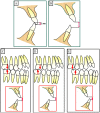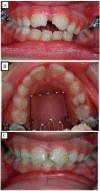Anterior Open Bite Malocclusion: From Clinical Treatment Strategies towards the Dissection of the Genetic Bases of the Disease Using Human and Collaborative Cross Mice Cohorts
- PMID: 38003932
- PMCID: PMC10672619
- DOI: 10.3390/jpm13111617
Anterior Open Bite Malocclusion: From Clinical Treatment Strategies towards the Dissection of the Genetic Bases of the Disease Using Human and Collaborative Cross Mice Cohorts
Abstract
Anterior open bite malocclusion is a complex dental condition characterized by a lack of contact or overlap between the upper and lower front teeth. It can lead to difficulties with speech, chewing, and biting. Its etiology is multifactorial, involving a combination of genetic, environmental, and developmental factors. Genetic studies have identified specific genes and signaling pathways involved in jaw growth, tooth eruption, and dental occlusion that may contribute to open bite development. Understanding the genetic and epigenetic factors contributing to skeletal open bite is crucial for developing effective prevention and treatment strategies. A thorough manual search was undertaken along with searches on PubMed, Scopus, Science Direct, and Web of Science for relevant studies published before June 2022. RCTs (clinical trials) and subsequent observational studies comprised the included studies. Orthodontic treatment is the primary approach for managing open bites, often involving braces, clear aligners, or other orthodontic appliances. In addition to orthodontic interventions, adjuvant therapies such as speech therapy and/or physiotherapy may be necessary. In some cases, surgical interventions may be necessary to correct underlying skeletal issues. Advancements in technology, such as 3D printing and computer-assisted design and manufacturing, have improved treatment precision and efficiency. Genetic research using animal models, such as the Collaborative Cross mouse population, offers insights into the genetic components of open bite and potential therapeutic targets. Identifying the underlying genetic factors and understanding their mechanisms can lead to the development of more precise treatments and preventive strategies for open bite. Here, we propose to perform human research using mouse models to generate debatable results. We anticipate that a genome-wide association study (GWAS) search for significant genes and their modifiers, an epigenetics-wide association study (EWAS), RNA-seq analysis, the integration of GWAS and expression-quantitative trait loci (eQTL), and micro-, small-, and long noncoding RNA analysis in tissues associated with open bite in humans and mice will uncover novel genes and genetic factors influencing this phenotype.
Keywords: Collaborative Cross mice; etiology; malocclusion; open bite; treatment.
Conflict of interest statement
The authors declare no conflict of interest.
Figures



















References
-
- Lin L.-H., Huang G.-W., Chen C.-S. Etiology and treatment modalities of anterior open bite malocclusion. J. Exp. Clin. Med. 2013;5:1–4. doi: 10.1016/j.jecm.2013.01.004. - DOI
-
- Kulshrestha R., Wajid M.A., Chandra P., Singh K., Rastogi R., Umale V. Open bite malocclusion: An overview. J. Oral Health Craniofacial Sci. 2018;3:011–020.
LinkOut - more resources
Full Text Sources

